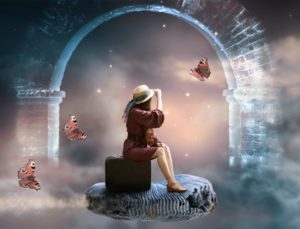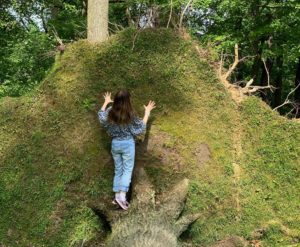
Talking to Angels
Have you been talking to Angels? Yeah, me too. How’s that going? (That’s a real questions.) I really wonder what it’s like for you when you chat with the Angels.


As a child, I was fascinated by tadpoles. And I wasn’t alone.
Freely roaming the neighborhood during summer months, we kids would gather in my neighbor’s frog enclosure to search for new life. When tadpoles first appeared in the manmade pond, we peered into the murky water.
Like curious child scientists, we observed the natural evolutionary process of this ancient species.
Between neighborhood games of sheep and wolf, picking berries from the garden, and sleeping under the stars, we tracked the tadpoles’ progress. Spending quality time on our bellies became an integral part of our playtime.
We were delighted by the alchemical process when tiny legs appeared.
As small arms grew and tails shortened, we knew to check the surrounding banks to ensure gradual slopes of dirt and rocks for the froglets to make their way onto land.
Beyond observerIng, we became participants in creating an environment to support progress.
The froglets had to navigate their way out of water in order to live and breathe on land. The water, which sourced early development, became deadly if they were unable to make the transition.
This unfolding mystery trained us as naturalists and strengthened our connection to the rhythms of nature.
Just the presence of enthusiastic playmates with curious minds and a sense of wonder for a complex ecosystem resulting from millions of years of evolution.
Looking back upon my tadpole research, I recognize the valuable modeling of how to live in an ever changing world.
Complex personal, societal, and global challenges requires us, like the tadpole, to grow legs, learn to breathe through change, climb out of our comfort zone, and skillfully navigate new terrain. The combination of outer turmoil and inner evolutionary pulsing invites the potential to adapt skillfully. As adults, we rely upon learned experience, cognitive problem solving, and well honed defense mechanisms to move through adversity.
Yet, the inner curious child scientist suggests a different approach.
Letting go the mind, we might breathe deeply, drop into (onto) our belly, and reconnect with the rhythm of our essential nature. Relaxed and open, we’re free to gaze into the murky situation. Seeking subtle clues which offer a broader understanding of the potential for transformation. From this vantage point, we may recognize that we are swimming in the evolutionary stream of life.
What began millions of years ago is unfolding through us, inviting the next phase of becoming.
What was once perceived as a problem may be welcomed as a necessary phase of our own evolution. Broadening our vision, we recognize that so many others, seen and unseen, have prepared the environment for our growth and cleared the way for our move into new territory.
Welcoming support makes sense as no one travels alone on the journey of life.
Swim. Climb. Leap.
My love affair with tadpoles taught me how every phase of development has value. That it is important to look beneath the surface, engage a sense of childlike wonder, and enlist playmates to make life’s journey more enjoyable.
This story also appears in Natural Awakenings Magazine, South Jersey and Philadelphia additions.
Peace be with you and with all. No exceptions.


Researchers suggest that early childhood years are fundamental in developing positive environmental attitudes and a commitment to caring for the Earth. With time playing in parks, forests, and playgrounds, children have the opportunity to reduce stress, engage in creative play, and explore the natural world. Research has found physical and psychological benefits including increased cooperation, verbal expression, and social comfort entering play with other.



Learn the one essential skill that allows you to face any challenge with confidence, sturdiness, and inner calm.
More than a technique. It’s a game changer.


Have you been talking to Angels? Yeah, me too. How’s that going? (That’s a real questions.) I really wonder what it’s like for you when you chat with the Angels.


I’m ready for something new. Time to shed a skin or two. Habits and thought patterns are stale. Begging me to begin a new tale.


I took a month away from social media to step away from the opinions of the world. This reprieve allowed me to enjoy the sweetness of my life and rest.


I am often jolted by what occurs in these Divided States of America. Jolted by those in your face reminders and occasional gut punch.


Walking with a friend last week on a gorgeous morning, we came upon the most magnificent tree. It was different than the rest of the sentinels along the path.


I’ve been dreaming a lot. Receiving instructions about how to live a more beautiful life. New information is streaming through my dreaming.

We use cookies to ensure that we give you the best experience on our website.